Embark on a journey to understand Flat Feet with our comprehensive guide. Discover the causes, symptoms, and transformative non-surgical treatments to navigate life with ease and comfort. Elevate your well-being and step into a world of pain-free mobility today.
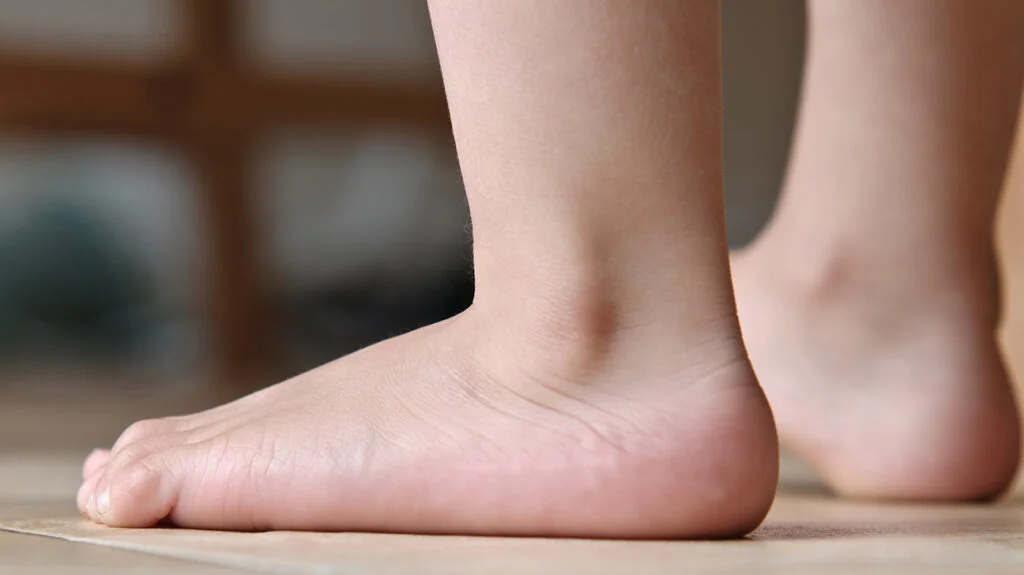
Introduction
Flat feet, also known as fallen arches, occur when the arches of the feet flatten, allowing the entire sole to touch the ground. This condition can be inherent or develop over time due to various factors. Our guide explores the roots, signs, and impacts of flat feet on daily life, offering hope and solutions for those looking to alleviate discomfort and improve their quality of life.
Table of Contents
Understanding Flat Feet

Flat feet, or fallen arches, is a condition where the arches of the feet are lowered or absent, causing the soles to make complete contact with the ground when standing. This condition might be congenital or develop over time due to various reasons. Here’s a closer look at the causes, symptoms, and the impact of flatten feet on daily life:
Causes of Flat Feet
Several factors can lead to the development of flat feet, including:
| Genetic Predisposition: A family history of flat feet increases your likelihood of having them. |
| Pregnancy: Hormonal changes during pregnancy can cause temporary or permanent changes to the foot’s structure. |
| Injuries: Damage to the foot or ankle can lead to flatten feet |
| Aging: The foot’s tendons can weaken with age, contributing to the development of flatten feet. |
| Obesity: Excess weight can put additional pressure on the arches, leading to flatten feet. |
| Medical Conditions: Diseases like diabetes and rheumatoid arthritis can affect the feet’s structure and function. |
What specific symptoms should individuals search for to identify flat feet?
Recognizing flat feet early can aid in managing the condition effectively. Key symptoms include:
| Pain: Discomfort in the feet, ankles, or lower legs, particularly after standing or walking for long periods. |
| Muscle Fatigue: The absence of arch support can result in feet that tire easily. |
| Arch Discomfort: Pain or strain in the arch area. |
| Overpronation: The feet rolling inward while walking, which can lead to alignment issues in the legs. |
Impact on Daily Life and Well-being
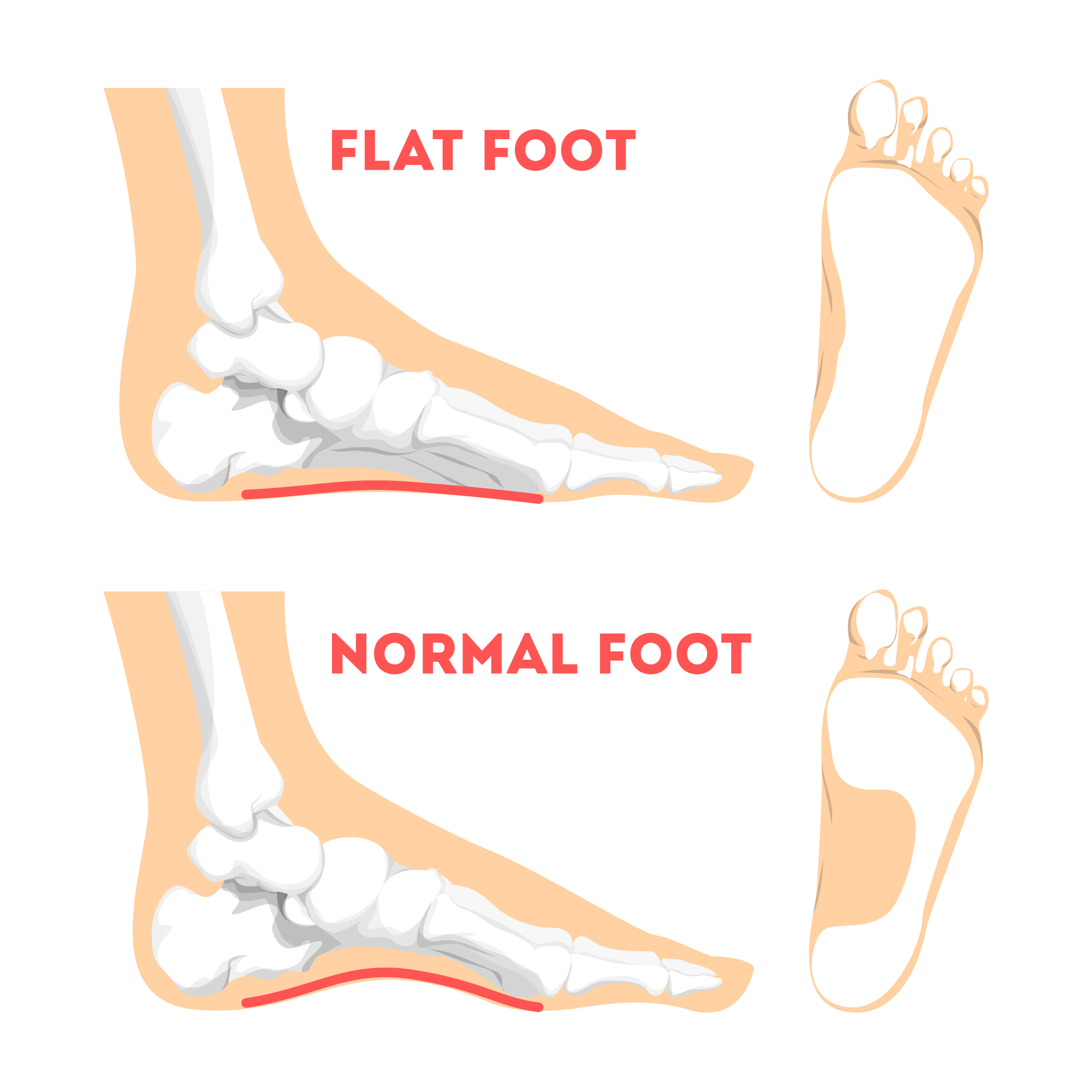
Flat feet can significantly influence daily activities and overall health:
Activity Restrictions: Pain or discomfort may limit participation in certain sports or physical activities.
Footwear Challenges: Finding shoes that offer adequate support and comfort can be more difficult.
Increased Injury Risk: The altered foot alignment associated with flaten feet can heighten the risk of injuries like ankle sprains and plantar fasciitis.
Chronic Pain: If not properly managed, It can cause persistent pain in the feet, ankles, knees, hips, and lower back due to misalignment of the legs.
What specific practical management tips (Non-Surgical Treatment) should individuals with flat feet follow?
Managing flat feet effectively involves a blend of daily practices, smart footwear choices, and long-term lifestyle adjustments. Here’s a straightforward guide to non-surgical approaches that can help you live comfortably with flat feet.
Daily Management and Relief
Stretch Regularly: Focus on stretches that relieve tension in your feet and calves, particularly targeting the Achilles tendon and plantar fascia.
Strengthen Your Feet: Engage in exercises to bolster the muscles supporting your arches. Activities like toe curls and heel raises can be beneficial.
Rest and Elevate Your Feet: After long periods on your feet, take time to rest and elevate your legs to decrease swelling and ease discomfort.
Seek Physical Therapy: A physical therapist can customize an exercise regimen for you, which may include techniques to strengthen foot and ankle muscles, enhance balance, and support your feet’s structure. Additional therapies might involve ultrasound, electrical stimulation, and hands-on therapy to reduce pain and inflammation.
Use Medications Wisely: NSAIDs can be effective in managing the pain and inflammation associated with flat feet.
Footwear Choices
Opt for Supportive Footwear: Choose shoes that provide good arch support and have a cushioned sole. Steer clear of flat and worn-out shoes.
Consider Orthotic Inserts: Both custom and over-the-counter orthotics can significantly support your arches, distribute pressure evenly, and correct alignment issues.
Ensure Proper Shoe Fit: Wearing shoes that fit well is crucial to avoid exacerbating foot pain and other complications.
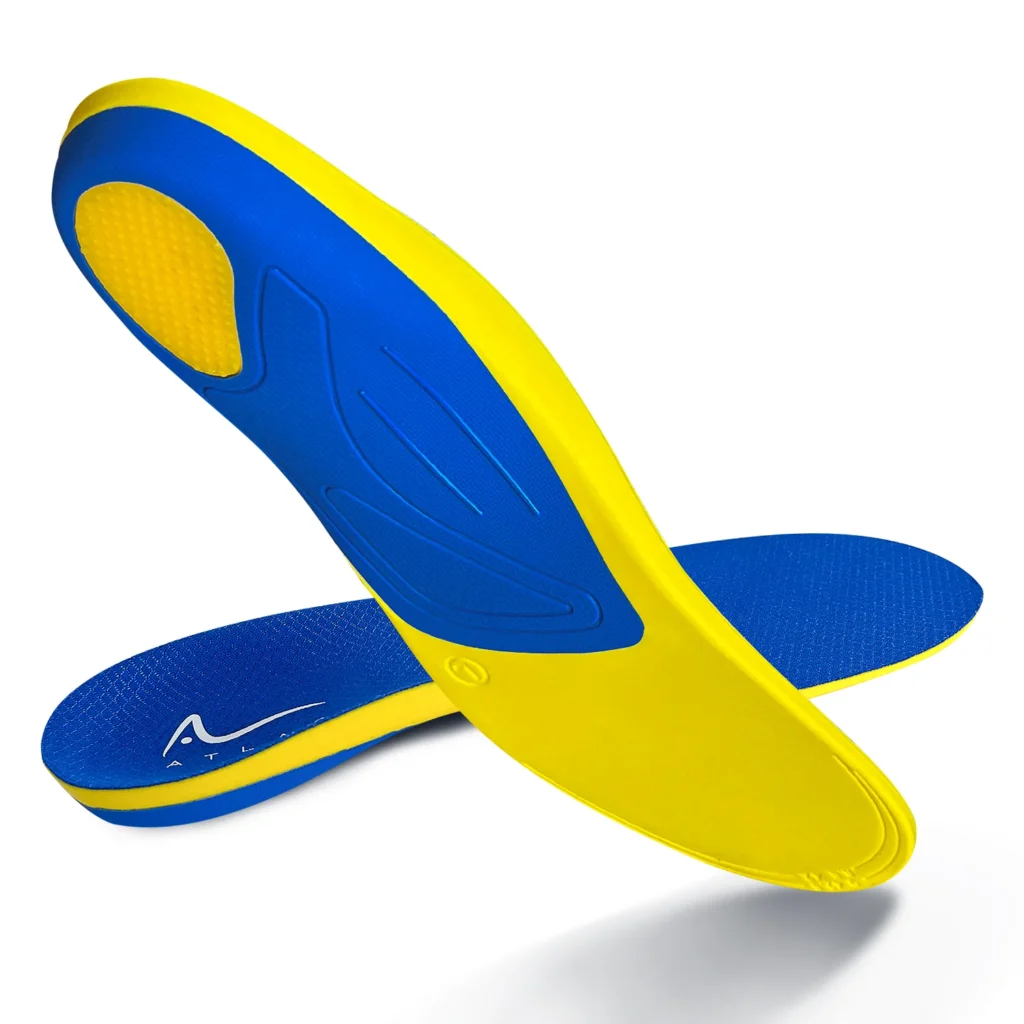
Long-term Care and Considerations
Manage Your Weight: Lightening the load on your feet by maintaining a healthy weight can reduce arch stress and alleviate symptoms.
Regular Podiatrist Visits: Keep up with routine check-ups to monitor your flatten feet and adjust your care plan as necessary.
Limit Aggravating Activities: Identify which activities worsen your symptoms and find lower-impact alternatives.
Consider Supportive Devices: For more severe cases, your doctor might recommend specific orthotics, ankle braces, or custom footwear.
Lifestyle Adjustments
Choose Low-Impact Exercise: Activities like swimming or biking are gentler on your feet than high-impact sports.
Maintain Good Posture: Proper alignment can help minimize strain on your feet, ankles, knees, and hips.
Stay Active, But Listen to Your Body: Keeping active is important, but avoid overdoing it and respect your body’s pain signals.
Professional Guidance is Key
Consulting with a healthcare provider is essential if you’re dealing with ongoing pain or discomfort due to flatten feet. They can offer a personalized management plan, which might include targeted physical therapy, exercise recommendations, or surgical options for more serious cases.
Navigating life with flatten feet is manageable with the right approach. By incorporating these tips into your daily routine, you can lessen discomfort, enhance your foot health, and maintain an active, fulfilling lifestyle. Always remember to tailor any advice to your unique needs in consultation with healthcare professionals.
What are the available surgical treatments for Flat Feet?
Surgical options may be explored for flat feet when non-surgical methods fail to alleviate severe pain or functional limitations. The choice of surgery is tailored to the individual’s condition severity, the root cause of flat feet, and their specific health profile.
1. Tendon Repair
For flat feet resulting from a compromised tendon, surgical repair can be crucial to mend the tendon and return the foot to its normal functionality.

2. Osteotomy
This technique involves surgically cutting and realigning the foot’s bones to reconstruct the arch and improve foot alignment.
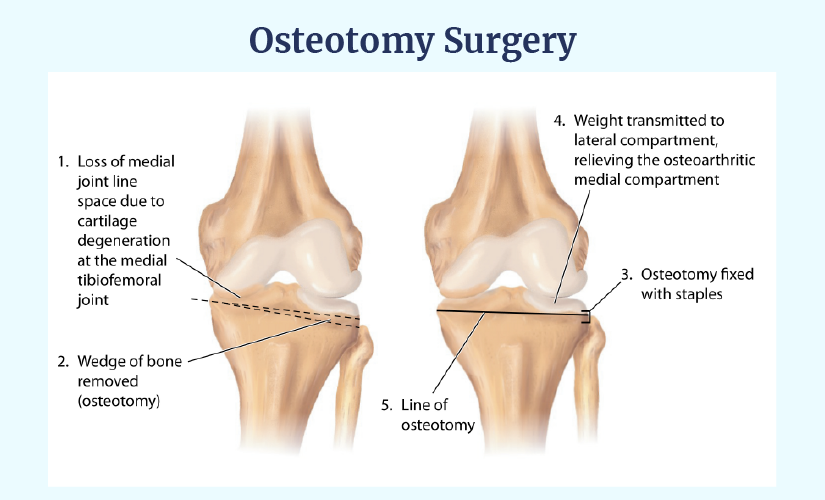
3. Joint Fusion (Arthrodesis)
Fusion surgery, or arthrodesis, fuses one or more of the foot or ankle bones together, aiming to correct deformities and provide stability to the foot.
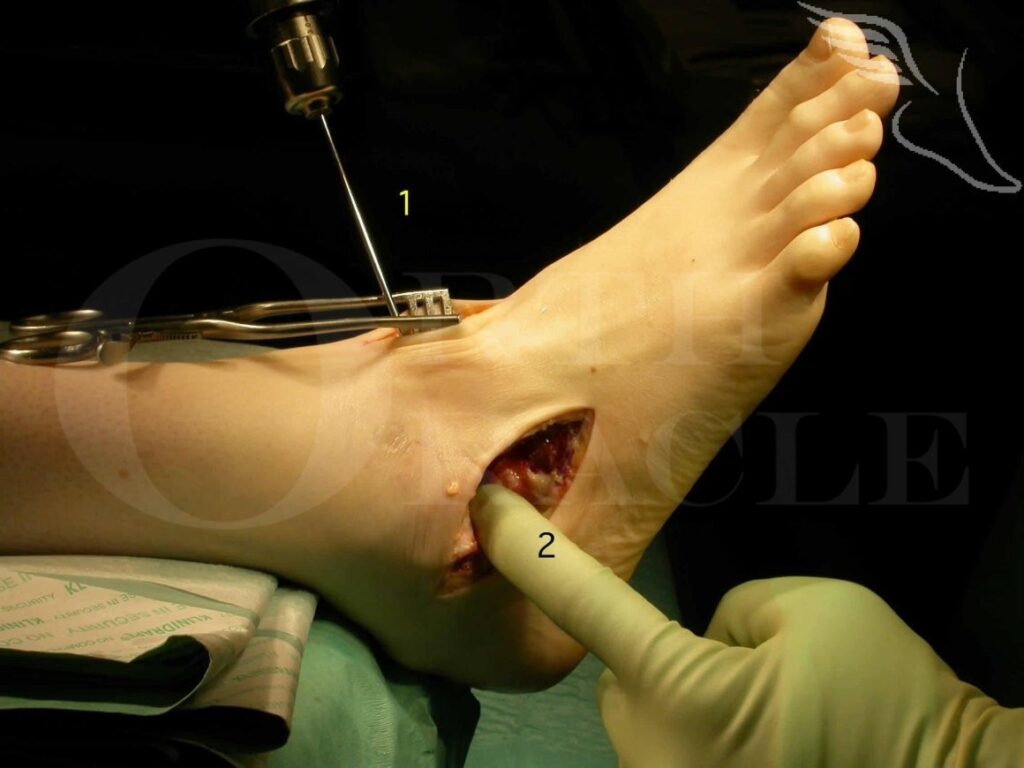
4. Lateral Column Lengthening
This procedure extends the outer side of the foot to correct the arch and better distribute body weight across the foot.

5. Implant Insertion
In certain cases, surgical insertion of implants can offer arch support, helping to stabilize the foot and prevent excessive inward rolling.
Considering Surgery
Opting for surgery is a significant decision that should be made after thorough discussion with a medical professional, such as a podiatrist or an orthopedic surgeon. Important considerations include the intensity of symptoms, the effect on daily life, and weighing the surgery’s potential risks against its benefits.
Frequently Asked Questions
Q: What causes flat feet?
A: Flat feet can arise from genetic predisposition, pregnancy, injuries, aging, obesity, and certain medical conditions, affecting the foot’s structure and function.
Q: How can I recognize flat feet?
A: Look out for symptoms like foot pain, muscle fatigue, arch discomfort, and overpronation. These signs can help identify flat feet early on.
Q: How do flat feet affect daily life?
A: Flat feet can limit physical activity, pose challenges in finding suitable footwear, increase the risk of injuries, and lead to chronic pain, impacting overall well-being.
Q: What non-surgical treatments are available for flat feet?
A: Management includes regular stretching, strengthening exercises, rest, physical therapy, appropriate medications, supportive footwear, orthotic inserts, weight management, and avoiding activities that exacerbate symptoms.
Conclusion
Living with flat feet requires understanding and adapting to your body’s needs. By incorporating daily management techniques, choosing the right footwear, and making informed lifestyle adjustments, you can significantly reduce discomfort and enhance your foot health. Remember, each individual’s experience with flat feet is unique, so it’s crucial to consult healthcare professionals for personalized advice and treatment plans. Embrace these strategies to navigate life with flat feet confidently and comfortably, ensuring a fulfilling and active lifestyle.


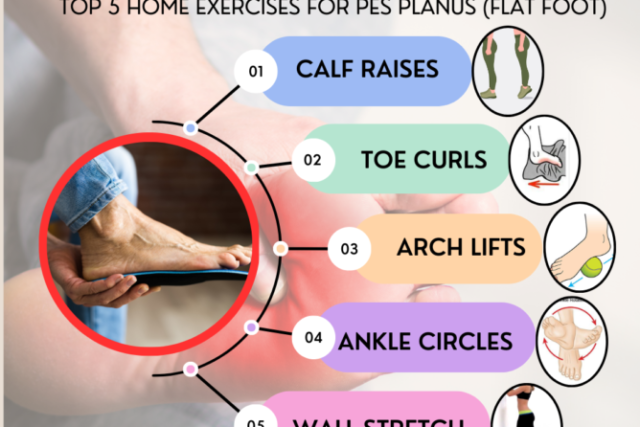
MOST COMMENTED
Animal-Based Proteins / Casein Protein / Dietary Protein / High-Protein Diets / Pea Protein / Plant-Based Proteins / Protein / Protein Deficiency / Protein Supplements / Proteins / Whey Protein / Whey Proteins
Is Protein Powder Safe for Teenagers and Children?
Animal-Based Proteins / Casein Protein / Dietary Protein / High-Protein Diets / Pea Protein / Plant-Based Proteins / Protein / Protein Deficiency / Protein Supplements / Proteins / Whey Protein / Whey Proteins
Unlock the Power of Proteins for Optimal Gut Health
Multivitamin
Total Health: Multivitamin for Active Lifestyles
Multivitamin
WellnessFusion: Complete Multivitamin Support
Dietary Supplement
Revitalize Your Health: The Magic of Red Yeast Rice Capsules
Foot care / Foot Health
Revitalize Your Foot Care Routine: Essential Tips for Optimal Foot Health
Foot Problem / Diabetics / Foot Health
Diabetics: Mastering Footwear Selection for Enhanced Foot Health and Ultimate Comfort
Exercises and Footwear Tips for Hammertoe Relief / Foot care / Foot Health / Foot Pain / Foot Problem / Hammertoes
Unlock Effective Exercises and Footwear Tips for Hammertoe Relief
Hammertoes / Foot Health / Foot Pain / Foot Problem
Unlock Relief: Essential Guide to Hammertoes Causes, Symptoms, and Treatments
Foot Problem / Foot Health
Revolutionize Your Recovery: Natural Remedies for Plantar Fasciitis – Fresh Home Keepers